by Dahna Branyan
When planning this trip, we were warned on a travel forum that the RV resort nearest to Joshua Tree National Park might be noisy due to wind generators. Boy howdy. Once past Palm Springs, the wind funneling through the San Gorgonio Pass between Coachella and San Bernadino valleys makes it a prime location for wind generation. I think the number of wind generators might possibly rival the number of Joshua trees in the park. Though not near as pretty, the generators appear to be keeping the lights on in Southern California. We opted to keep going, fighting the mighty headwinds to park the camper in Yucaipa.

This was the smart choice. Yucaipa Regional Park is a gem – spacious sites with lots of trees and grass and three small lakes. As we met other new arrivals to the park, we were met with comments like, “Can you believe this beautiful place?” Although sycamores and eucalyptus trees dominate the park, there were a number of plantings of other trees, like Japanese Larch, Redwood and Incense Cedar.
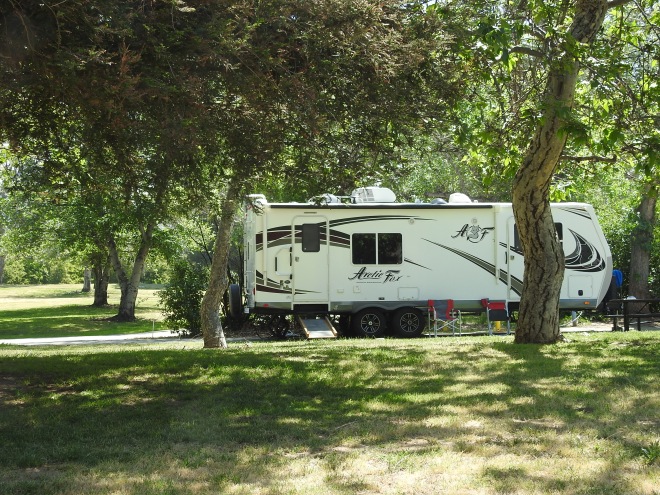
And did I mention birds? As soon as we got out of the truck, I spotted a new (for me) species, A Nuttall’s Woodpecker. Notice how the barring stops lower on the back than a Ladder-backed Woodpecker.

We saw several other new birds for us, including this Plain Titmouse perched in a white alder. I never knew that alders had cones!

Lawrence’s Goldfinch – this pretty little finch’s breeding territory is limited to Southern California and sometimes Arizona. Interestingly, the males gain a more intense yellow coloring from wear rather than through molting, as brown feather barbules wear off to expose the underlying yellow.

Hooded Oriole – these orioles are limited to the southwest, breeding along the US/Mexican border area from Texas to California.

The next day we were off to Joshua Tree National Park, back over the San Gorgonio Pass (and wind generator tunnel). The Oasis of Mara was our first stop after entering the park. It is one of five oases within Joshua Tree National Park, where uplifts of hard rock layers allow water to move to the surface. These oases are prime habitats where California fan palms flourish. They were once relied upon by Native Americans as watering holes and places to gather palm nuts to grind into meal.
Oasis of Mara
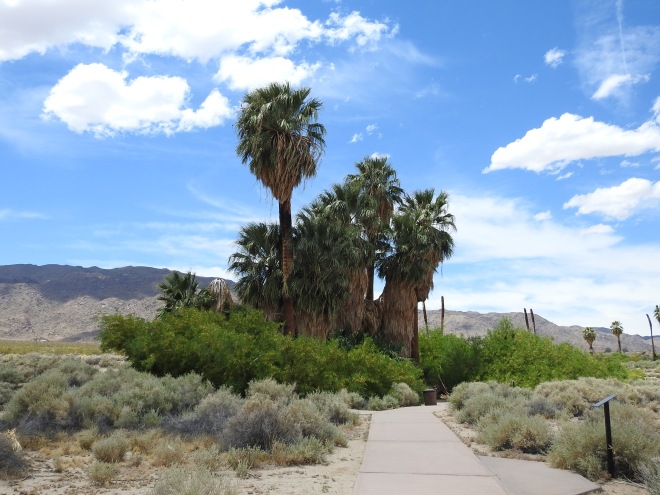
Expecting to visit a flat desert terrain dotted with cactus and yuccas, we were astounded by the wonderful rock formations, eons in the making, standing like colossal monuments in the desert.



The Joshua Tree, or Yucca brevifolia, can be found throughout the park loop. These trees grow quickly, 7-8″ per year at first, then more slowly, 1-2″ per year after about ten years. They top out at about 15 feet. Their roots go deep, and many can live hundreds, even thousands of years. While it can grow from seed, it also spreads from underground rhizomes.


Joshua trees don’t bloom every year, but due to a wet spring, they were still blooming during our visit. The flowers rely on Yucca Moths for pollination. Afterward, they form fleshy green fruits, seen in abundance. The moth caterpillars stick around to feed on the seeds. Besides the moths, only small mammals seem to feed on the seed. Since they have a relatively small range to scatter seeds through dung deposits than birds might, the Joshua tree can’t easily expand its range. This might be problematic as climate change accelerates.
Joshua Tree Blossom
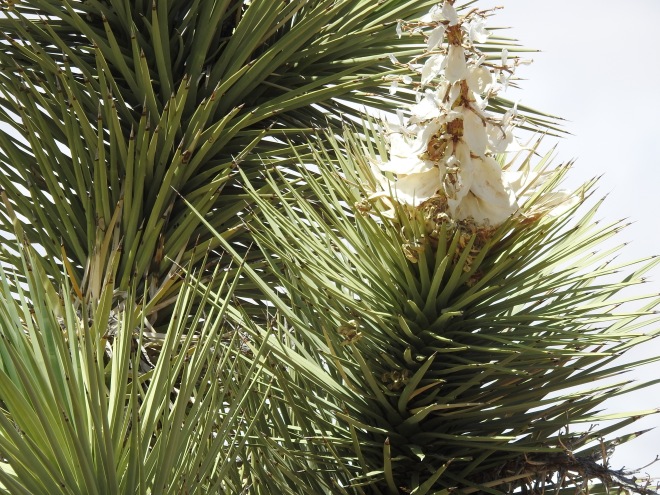
The wet desert spring had many other plants showing off their blossoms in an impressive show of appreciation. Nature dressed up in its Sunday best.
Apricot Mallow (Sphaeralcea ambigua)
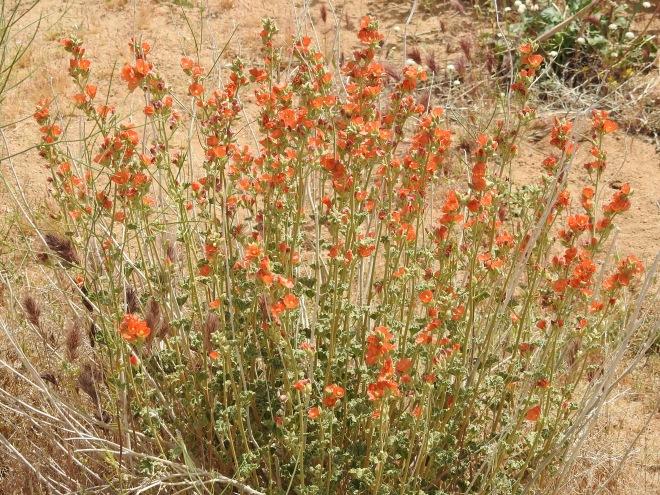
Mohave yucca (Yucca Shigedera)
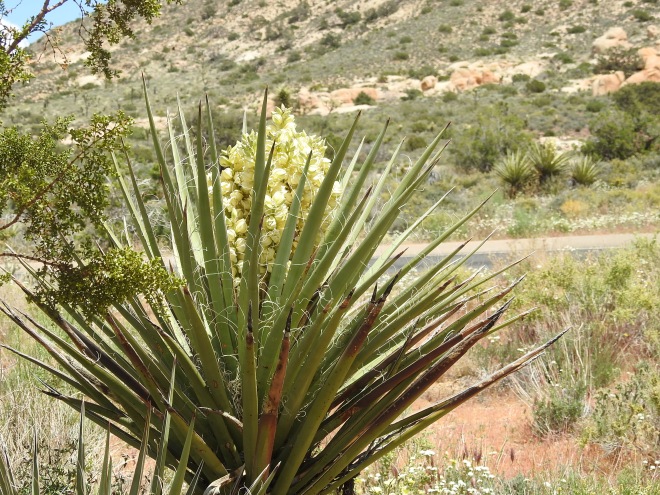
Desert Canterbury Bells (Phacelia campanularia)

Mojave Pin Cushion (Chaenactis xantiana)

Mojave kingcup cactus (echinocereus mojavensis)

After an eye-popping day of the best the desert has to offer, we retreated back to the San Bernadino Valley and Yucaipa to rest up for the next leg of the trip and of course, look for more new birds. Sacha was having none of the birds. She had discovered gophers.
Before leaving on this trip, we took Sacha to the vet for a rattlesnake vaccine booster. The vet, when learning that we were going to Joshua Tree, warned us about the Mojave Rattler. The vaccine would be worthless against this particular snake’s venom because it contained a strong neurotoxin. While we fretted about that, unaware that Sacha would not be allowed on the trails, she developed a fixation on the many gophers aerating the soil in our campground. Sticking her nose in every hole, she finally snatched one out of it’s home. Pat may or may not have saved it from her death grip. She dropped it and he hustled her back to the camper. Going back to see how the gopher fared, it was gone. A raven might have picked it up, but we like to think the little rodent was only playing possum and returned to its underworld labyrinth to lick its wounds.
Sacha Waiting To Pounce On the Next Unlucky Gopher

Canyon Wren Belting Out His Sweet Song

Western Bluebird with Anna’s Hummingbird
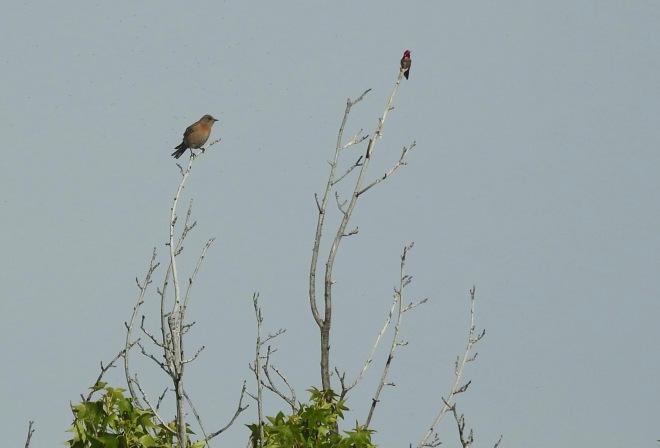
Blue-gray Gnatcatcher (notice the nest to the left) Both the male and female were tending to the nest, but they were so fast, I could only catch one on film.

Olive-sided Flycatcher – Similar to the Eastern Phoebes we have at home, I watched this one return again and again to the same perch after snaring an insect meal.

If the darn gasoline and real estate weren’t so expensive, I might have convinced Patrick to retire to this little bit of heaven. But gasoline was well over $4/gallon and real estate well out of our price range. Most of the Californians we met loved living here except for the high cost of living. There’s still “gold in them thar hills,” but it’s in the real estate, I suspect.
We could have stayed much longer in Southern California, but bigger trees were calling. Next stop, Sequoia National Park with the generals, Sherman and Grant.
Such beautiful bird and plant pictures. I stole the Yucca brevifolia for my desert biome lecture! Looks like the whole crew is having a blast! Sasha won’t soon forget those gophers.
LikeLiked by 1 person
Thank you, Allan. Wish you could have been there to enjoy the flora with me – I know I would have learned more with you along. Unfortunately, Sacha has continued her gopher obsession throughout the west.
LikeLiked by 1 person